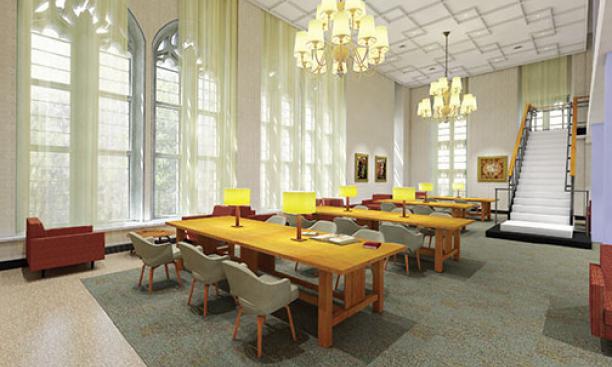

Six years ago, along with members of the faculty steering committee for the Firestone Library renovation, I toured libraries at several universities and met with architects who had worked on other library renovations. An important theme emerged from those visits, as my colleagues and I saw firsthand how libraries reflect the distinctive mission — the soul, one might say — of their institutions.
The current Firestone renovation exemplifies Princeton’s vigorous commitment to the humanities and liberal arts education. Our aim is to elevate the Princeton experience by sustaining and enhancing Firestone’s status as one of the world’s greatest research libraries. The project will preserve Firestone’s scholarly character while improving navigability and creating genuinely jewel-like study spaces that invite readers and inspire scholars.
At a time when governments around the world have unconscionably sacrificed humanities funding in the quest for short-term returns, our investment in the Firestone renovation reaffirms Princeton’s enduring belief in the ideals that led to the library’s opening in 1948 as a “laboratory for the humanities and social sciences.”
The idea of a “laboratory-library” at Princeton traces back to Professor Charles Morey, who in 1933 called for collections and spaces that would, in the words of historian James Axtell, “foster departmental esprit de corps by placing student carrels, graduate reading rooms, faculty offices, and seminar rooms in the midst of the book stacks of mutual interest.”
Morey’s architectural principles reflected Princeton’s distinctive educational ethos — and they still do. His successors on the current faculty steering committee emphasized the need for improved graduate study rooms, located near relevant collections, because of Princeton’s commitment to train the next generation of scholars in the humanities. And, unlike at other universities that create separate spaces or even separate libraries for undergraduates, Firestone’s design deliberately mixes undergraduates, graduate students, and faculty members — as is fitting for a university where every undergraduate researches and writes a thesis and where every faculty member teaches.
As Morey envisioned eight decades ago, today’s faculty members and students intersect around Firestone’s materials in a dazzling variety of ways. Steering committee member and Professor of Classics Joshua Katz, for instance, introduces students to our Rare Books and Special Collections in his freshman seminar on “Ancient Egypt and Its Hieroglyphs.” Associate Professor of English Meredith Martin, meanwhile, is working with University Librarian Karin Trainer to spearhead a digital humanities initiative that will incorporate next-generation computational tools into humanistic research — exemplifying our efforts to modernize Firestone’s resources while still serving its mission as a home for books and an incubator of ideas.
Of course, for students and faculty alike, Firestone’s open stacks remain both the literal and metaphorical core of the library. The need for dedicated stewardship of Firestone’s browsable collection was expressed astutely by Professor of History Martha Sandweiss, whose comment to a University trustee I have often repeated. Asked why Firestone had to house so many books that were rarely checked out, Professor Sandweiss observed that her graduate students will find the germinal discoveries for original research not in oft-read, well-known books but in forgotten passages from books that others have neglected or overlooked.
Thanks to the generosity of William H. Scheide ’36, Lloyd Cotsen ’50, Leonard Milberg ’53, and many other stalwart friends, Firestone’s magnificent collections are lush with intellectual treasure. But much of its interior aesthetic has seemed, even to those of us who love Firestone, at times too faithful to the “laboratory” metaphor: functional and muscular rather than warm and embracing.
Through the vision of Karin Trainer, University Architect Ron McCoy, and our distinguished design partners at Shepley Bulfinch and Frederick Fisher and Partners, the renovation will give Firestone the grace and beauty that a great library deserves. Change is evident already. Stop by when next you are on campus, and you will find light-filled stacks on A Floor and a gloriously restored third-floor reading room (formerly a faculty lounge later cannibalized by book stacks).
More splendid spaces are to come. Much like renovating a ship at sea, the library must remain open and fully operational while the renovation proceeds. That takes time. Planning began in 1997 for a comprehensive renovation to meet the needs of 21st-century students and faculty. Work commenced in 2010 and will continue through 2018. Details and updates can be found on the excellent Firestone Library Renovation blog at http://libblogs.princeton.edu/renovations.
Seeing the renovation take shape is immensely gratifying. Early in my tenure as provost, Anthony Grafton, the Henry Putnam University Professor of History, told me the most important thing Princeton could do for the humanities was to renovate Firestone Library. Today, as president, I am proud of the University’s distinctive and profound commitment to ensuring that our magnificent library will foster scholarship and fellowship in brilliant fashion for generations to come.

